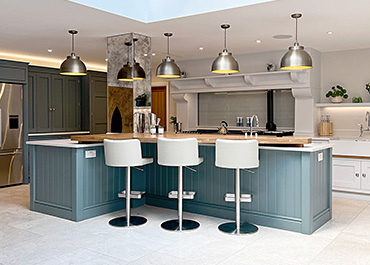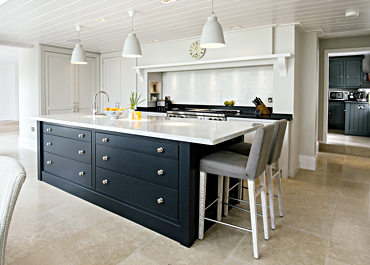Traditionally, a boot room conjures up images of a rambling estate or manor with acres of land and multiple spare rooms for holding vast swathes of equipment.
However even the most modest sized homes can find some space for at least a good proportion of the most-used outerwear, laundry appliances and animal associated paraphernalia, it just takes a little focus and some considered planning.
Keepers of dogs, horses or indeed any animals, inside or outside dwelling – and those with a general persuasion towards outdoor activities – will know just how useful the boot room is to offer the household a dedicated area to perform a multitude of tasks that aren’t quite suitable to do outside, nor are they ideal to do in the heart of the home.
‘Boot room’ might be the catch-all term most given to this kind of space, but it can be called a utility room, cloakroom, laundry room, mud room, kit room or simply ‘the hallway’. Whichever way it’s referred to, the purpose here is usually to maximise space, keep often dirty, muddy or cumbersome items accessible without cluttering entrances, while also keeping clean carpets and furnishings within the house itself separate from the gritty reality of outdoor pursuits (however enjoyable they may be!).
Practical yet beautiful
That’s not to say a fitted boot room can’t be beautiful and in keeping with your home and style. Just because it needs to be a practical, durable and hard-wearing zone, capable of withstanding various conditions and a range of punishments, there’s still plenty of scope for pleasing aesthetics and creating comfort.But there are some key functions that a boot or utility room will be expected to deliver; what you have in yours will vary depending on your personal circumstances and requirements, but generally speaking, those creating a bespoke space like this will be looking for somewhere that:
- Eliminates muddy, wet or dirty articles from the kitchen or bathrooms
- Offers a space to put on, take off and clean mucky clothing, outerwear and footwear
- Provides efficient storage, with quick and easy access at the same time
- Affords protection of items from the elements when not in use, keeping them dry

What goes in a boot room?
The features of a boot room or utility depends on what it’s going to be used for, and of course on the amount of space available to use.Hang it all
There may be an entire family’s wardrobe of coats, jackets, hats and footwear to accommodate, which will need hooks, pegs and rails, with shelving, drawers and cupboards to keep items within easy reach, yet clean and tidy.
Oh sit down
Seating (with underneath storage options) for comfortably putting on and taking off hiking boots, wellies or paddock boots might be a priority for your rambling, riding or farming household and it’s likely that plenty of pegs, racks and shelves will be high on your list.
Keep it clean
A deep sink with draining area, if space allows, can be an intrinsic part of a bespoke boot room design, ideal for rinsing off muddy footwear, or perhaps as an extension to the kitchen for cleaning and preparing quantities of home-grown vegetables or other produce. And the laundry lovers will find a sturdy, non-porous butler’s sink invaluable for pre-treating clothes, bedding and the like while still keeping the look of the room smart, clean and fresh, regardless of the room style..
Don’t go in there! Yet…
The provision of dog beds, brushes, blankets, pet feeding areas, storage of leashes, dog coats, harnesses or other often used pieces of tack could be something your room has to feature. Keeping wet and muddy dogs from racing into the home and straight onto your best furniture (at least until their towelled off!) will surely be a good move for all concerned.
Laundry options
Should the focus of your room design be more utilitarian, you’ll want a washing machine and tumble dryer of course, but how about incorporating natural drying space too, either with a floor-standing drying rack or an over the door airer if floor space is limited. Likewise, maximise capacity with a door mounted or even a ceiling pulley clothes airer. Hampers or baskets keep the dirty washing out of sight, while racks and rails are ideal for keeping freshly folded linens and hanging clean shirts until they’re ready to take into the bedroom, dressing room or wardrobe. Store irons, ironing boards and steamers away behind fitted cabinetry, with washing detergents, softeners, starches and sprays tucked out of sight inside small cupboards or deep drawers.
For the big size 9s
Hard wearing flooring is essential, so consider the practicalities of what goes underfoot; natural materials such as tiles, brick or stone may be better with a dark grouting, and luxury vinyl tiles, sheet vinyl or even water resistant laminate flooring can be found in beautiful wood or tile designs
whatever you choose, remember that it will very likely get dirty – make sure it can be deep cleaned with ease. And finding good sized, robust doormats with a boot scraper and boot jack in close proximity will help collect mud, dirt and general detritus and keep it from being traipsed though to the inner rooms of your home.
Let it breathe
Ventilation is important for boot rooms no matter their size, those accommodating washers and dryers may need an extraction system while those without will benefit from natural ventilation options, such as stable doors to keep the room fresh.
A well-aired boot room is vital to ensure outerwear and clothing gets dried out and helps prevent items from becoming damp, mildewed or musty.
There is the subject of warmth; if pets are going to sleep in the space, it could be in need of a radiator to take the chill from the air in cooler months and will also serve to dry out wet kit more quickly too. Underfloor heating might sound like a real luxury, but many boot room owners swear by it.
What’s the best way to make the most of small boot or utility room?
Similarly, as with other room designs, there are a number of clever ways to maximise storage; from using floor to ceiling cupboards and durable panelling (to conceal a multitude of objects), through to giving the illusion of more space with clever choices of cabinetry, wall and ceiling colours.Natural light or creative lighting will undoubtedly give the impression of a larger room but enlisting the help of an experienced fitted boot room designer is certainly going to be your best option.
Having a wishlist to share with your designer at the beginning of the process will really help as they will work with you to squeeze every available centimetre of space possible to be used practically and to best effect.
How much does a boot room cost?
There’s not a hard and fast answer to this question, given the broad range of possible configurations, materials used, overall size and finishes that can be utilised.Thomas & Thomas have delivered compact through to large-scale room designs, each one with a different cost. As a rough guide an average Thomas & Thomas project of this nature is an average of £40,000 – but a consultation will definitely be worth arranging to obtain an estimate based on your requirements.
How do I find a boot room designer?
Consult a designer with experience in creating fitted boot and utility rooms; Thomas & Thomas have years of working with clients to bring the best possible results based on desires, requirements and resources. We are proud of the relationship we build with our clients throughout the entire design process, coupled with the quality of service, materials and years of expertise that ensures commissioning us an enjoyable experience.
Bespoke Kitchens & Bootrooms
Our unashamedly personal, design experience starts with a call or by sending us your enquiry online then is followed with a visit to your property by Robert, our Design Director.







